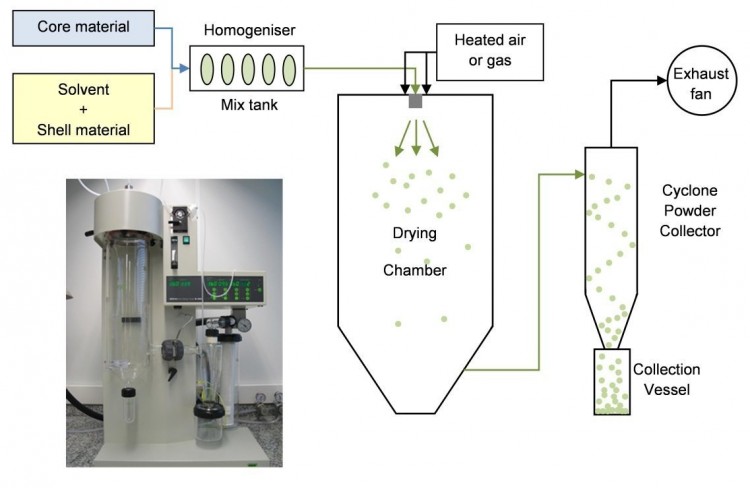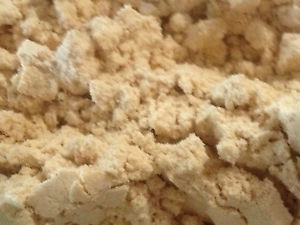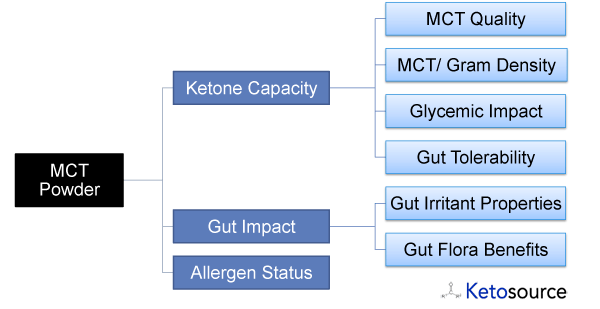Read on as we explain and uncover:
- What Is MCT Powder?
- How Is MCT Powder Made?
- MCT Powder vs MCT Oil
- What To Look For When Buying MCT Powder
- The Latest MCT Powder Innovations
- MCT Powder Comparison
What is MCT Powder? How is it Made?
MCT powder is a powdered form of medium-chain triglycerides.
The production process is similar to making protein powders. This process is called spray drying.
However, for MCT, this process converts it from a liquid (MCT oil) to a solid form (MCT Powder). Liquid MCT oil is spray dried and micro-encapsulated with a powder “carrier shell”. This gives it the look and convenience of a powder.

Clarification: MCT powder does not contain beta hydroxybutyrate (BHB) or ketone salts. This contrasts with exogenous ketone products (which we covered before here & here). For example, Keto Kreme by Pruvit does not contain BHB.
The Main Difference – What is in the Ingredients?
The powder is generally made of starch derivatives and milk proteins. These ingredients are not used in the pure MCT oil or caprylic acid oil products. Carbohydrate and protein based support powders can raise insulin levels. Therefore, the MCT powder formula needs to be carefully selected. The aim is to prevent insulin spikes. Below is a list of the most common powder ingredients used for MCT powders:
-
- Maltodextrin
-
- Glucose Syrup Solids
-
- Sodium Caseinate
-
- Soluble Corn Fiber
-
- Soy Lecithin
The exact amount of carbs and protein in the final MCT powder varies. It is based on the ratio of powder used. Typically, the powders are between 50% and 80% oil based with the rest made up by the powder carrier.
Why Use MCT Powder vs. MCT Oil?

The main advantages of converting MCT oil to a powder product include:
-
- Adding to solid products. For example, adding them to a baking recipe or another powdered product. Controllable “slowed” release of the MCT oil during consumption.
-
- MCT powders are an easy on-the-go option in single serving sachets. Powders are easier to transport than liquids.
-
- Many people can experience gut distress (diarrhea or “the runs”) issues when taking MCT oils. Anecdotal feedback suggests that MCT powders are much more tolerable. You can take greater amounts of MCT, and even double the ketone impact vs. standard MCT oils.
- You can stack MCT powder with ingredients that boost blood ketones (such as BHB mineral salts). This augments the effect (see graph below). The MCT powder works as a good carrier for BHB mineral salts in the body. See the complete discussion of using BHB mineral salts to raise ketones for context.
- Powders provide an alternative rich texture with potential for flavoring. Many people use the MCT powders as a “creamer” for coffee or hot drinks. Flavored varieties are available depending on the company and product you use.
Effects of Naturally-Derived Ketone Supplements on Blood BHB Levels [note]Kesl, S. L., Poff, A. M., Ward, N. P., Fiorelli, T. N., Ari, C., Van Putten, A. J., Sherwood, J. W., Arnold, P. and D’Agostino, D. P. Kesl, Shannon L. et al. “Effects Of Exogenous Ketone Supplementation On Blood Ketone, Glucose, Triglyceride, And Lipoprotein Levels In Sprague–Dawley Rats“. Nutrition & Metabolism 13.1 (2016): n. pag. Web. 23 July 2016.[/note]

- BMS (Beta-hydroxybutyrate Mineral Salt) – sodium/ potassium based (similar to KetoForce)
- MCT (medium chain triglyceride oil)
- BMS + MCT (1:1 mixture of beta-hydroxybutyrate mineral salt and MCT oil)
Benefits of MCT Powder Use: The Research
To date, nearly all research on the benefits of MCT supplementation has used MCT oil, and not MCT oil powder.
Researchers have noted that you are able to increase blood ketones up to two-fold higher than plain MCT oil. You can consume more MCTs in the powder form and avoid the GI distress potential of the oil form.
Nonetheless, the benefits of MCT oil powder should be identical to the benefits of MCT oil. The only difference is the delivery.
There are many researched benefits to MCT intake including:
- Improved blood lipids
- Increased energy expenditure
- Weight loss
- Neuroprotection
- Potential reduction in risk of cancer
We will cover the research benefits of MCTs in general in a future in depth article on MCT oil.
[optin-monster-shortcode id=”ikv7gceyqc4xxsjxlh6k”]
What to Look For in MCT Powders
As noted in the product comparison table MCT powders come in either premium brand-name iterations or in bulk with a generic label.
While generic MCT powders come with a better price tag, they make some quality tradeoffs to make up for the reduced cost. These quality tradeoffs determine the ketone driving potential of the MCT powder, whether it has positive or negative gut impacts and its allergen-free status (e.g. gluten, dairy).

The key differences to be aware of between MCT powders are the following:
- Grams of Active Ketone-Producing MCTs: The percentage of the MCTs that produce ketones (i.e. C8 and C10). The total grams of MCT oil vs. other ingredients per gram of product.
- Quality of Powder Carrier: All powders “carrying the oil” have different properties. Some add negatives (e.g. being high glycemic or gut irritants). Some add benefits (e.g. promoting beneficial gut flora growth).
- Non-Allergen Status: The use of GMO, gluten, dairy-based or derived ingredients.
Grams of Active Ketone-Producing MCTs
The end benefits from consuming MCT powder comes from its ketone producing benefits. This, in turn, depends on the total grams per unit and quality of the MCT oil (in terms of ketone producing capacity).
First, consider what the ratio of MCTs to powder (and other ingredients) by weight a product has. This can vary between 80% – 50% oil to powder ratio. Therefore providing more or fewer MCTs per gram. An MCT powder with an 80% oil to powder ratio provides significantly more MCT oil per gram than its 50% counterpart.
By comparing products nutrition facts you can estimate the MCT (fatty acid) to non-MCT ratio.
Second, the quality of the MCT oil itself matters. MCT oils on the market are a combination of C8 (Caprylic Acid), C10 (Capric Acid) and C12 (Lauric Acid). Only C8 and C10 provide the ketone producing benefits, and C8 is the most effective. So you’re looking for the highest concentration of C8, with C10, but avoiding C12 products.
For a discussion on why C8, Caprylic Acid, drives more ketones than other oils read this article.
Quality of Powder Carrier: Gut & Ketone Supporting or Negating Properties
There are a wide variety of powder carriers being used for MCT powders already. Unfortunately, these are not always reported in the ingredients.
The first and most simple rule to follow is to avoid high-glycemic powders. Ketones can offset the glucose and insulin spiking effects of these ingredients. However, the balance will give higher glucose levels with higher glycemic ingredients. This is counter-productive to achieving ketosis in general.
When purchasing MCT powder, assume you are getting glycemic maltodextrin or glucose-syrup solids. These reduce the cost of manufacture. The nutrition facts show the carb content of each product. In the U.S., this combines both non-glycemic fiber and glycemic carbs. Look for Carbs – of which sugars for the glycemic part if reported.
We recommend purchasing products that list the ingredients of their MCT powder. You can also track your blood ketones and glucose 30 minutes after consuming a product to be sure.
The second rule is in relation to gut health. Certain carbs and proteins used in powdered MCT products are potential gut irritants. Maltodextrin, is a good example.
On the other hand, some digestion-resistant starches (such as soluble corn fiber and cyclic dextrin) appear to promote digestive health. They influence the growth of microbiota in the gut and alter the morphology of gut tissue[note]Knapp, B. K., Bauer, L. L., Swanson, K. S., Tappenden, K. A., Fahey, G. C., & De Godoy, M. R. (2013).Soluble fiber dextrin and soluble corn fiber supplementation modify indices of health in cecum and colon of Sprague-Dawley rats. Nutrients, 5(2), 396-410.[/note].
Non-Allergenic: Corn Derived, Sodium Caseinate etc.
Many of the basic MCT powders contain ingredients that some people will want to avoid for allergenic reasons (or if they follow a diet aiming to be low allergen such as Paleo for example).
The two main ingredients that worry people are Corn-derived (especially if GMO) and dairy protein derived, Sodium Caseinate.
Note of warning: In some MCT powders the ingredients of the powder are not reported. They just state “MCT Powder” in the ingredients list. They do not state the actual powder or other carriers used. If you are aiming to avoid these types of ingredients, avoid products without single listed ingredients.
Specialized MCT Powders / Latest Product Innovations
While pure MCT powders are making waves in the supplement industry, there are other new products on the market. These combine exogenous ketones (BHB salts) with MCT powder to enhance their effects. An example of this type of combined product is Keto OS.
Another product that differs from others is Bulletproof’s Instamix. This combines grass-fed butter and the Brain Octane caprylic acid oil. The result is a product that may be higher in caprylic acid content than other MCT powders. Unfortunately fatty acid breakdown is not reported.
Comparison of MCT Powders Currently Available
| Company | Product | Size (g) | Price (£GBP) | MCT Quality | Powder Quality | % MCT | % Net Carbs | Price per MCT Gram | Other Added Ingredients |
|---|---|---|---|---|---|---|---|---|---|
| Prüvit | Keto Kreme (15 Packets) | 336 | 74.93 | LOW: Typical MCT composition (C8, C10 & C12) | MEDIUM: Unknown (probable in part sodium caseinate) | 0.66 | 0.17 | 0.3378878066 | Ceylon Cinnamon, Stevia |
| Quest Nutrition | MCT Oil Powder | 454 | 26.97 | LOW: Unknown MCT composition (probable same as their MCT product, i.e high C12 Lauric Acid content) | MEDIUM: Soluble Corn Fiber, Sodium Caseinate, Sunflower Lecithin | 0.77 | 0.11 | 0.07714972252 | Silicon Dioxide |
| Nourish Balance Thrive | Phat Fibre | 454 | 31.25 | Unknown MCT composition | MEDIUM: Digestion-Resistant Maltodextrin (gut flora benefits) | 0.6 | 0.37 | 0.1147209985 | |
| Bulletproof | Instamix | 259 | 31.95 | HIGH: Combination of Caprylic Acid Triglyceride (C8) and grass-fed butter fatty acids | MEDIUM: Highly Branched Cyclic Dextrin (gut flora benefits) | 0.7 | 0.27 | 0.1762272477 | Sorbitol, Vitamin E TPGS |
| TheProteinWorks | MCT Powder | 500 | 19.46 | Unknown MCT composition | LOW: Typically Malto Dextrin and Glucose Syrup (Glycemic impact and potential negative gut impacts) | 0.7 | 0.3 | 0.0556 | |
| MyProtein | MCT Powder | 500 | 25.99 | Unknown MCT composition | LOW: Typically Malto Dextrin and Glucose Syrup (Glycemic impact and potential negative gut impacts) | 0.74 | 0.16 | 0.07024324324 | Emulsifier (E472c) |
| BulkPowders | MCT Powder | 500 | 25.99 | Unknown MCT composition | LOW: Typically Malto Dextrin and Glucose Syrup (Glycemic impact and potential negative gut impacts) | 0.7 | 0.23 | 0.07425714286 | |
| Ketosource | Pure C8 MCT Powder 1.0 | 450 | 22.67 | HIGH: 99.8% C8 MCT | HIGH: Acacia Fibre (Gut beneficial, non-glycemic) | 0.3 | 0 | 0.1679259259 | Silicon Dioxide |
| KetoSports | MCT Powder | 270 | 18.69 | Unknown MCT composition | Dairy based. | 0.6 | 0 | 0.1153703704 | Non-Fat Dry Milk, Disodium Phosphate, Silicon Dioxide |
* KetoKreme active MCT % unknown. This is due to coconut shortening powder fatty acid presence.
** Bulletproof Instamix active MCT % unknown. This is due to grass-fed butter fatty acid presence.
The Main Takeaways
MCT powders are an easy and effective addition to a keto lifestyle. Most people find it easy to add them into their life – mainly in their hot beverages.
The benefits of MCTs span a broad range. Research needs more studies on the effects of powdered MCT products (as opposed to MCT oil).
Though generic MCT powders come with a better price tag they cut corners. They are not appropriate for a keto lifestyle. These products use glycemic carbs such as glucose syrup for the powder base.